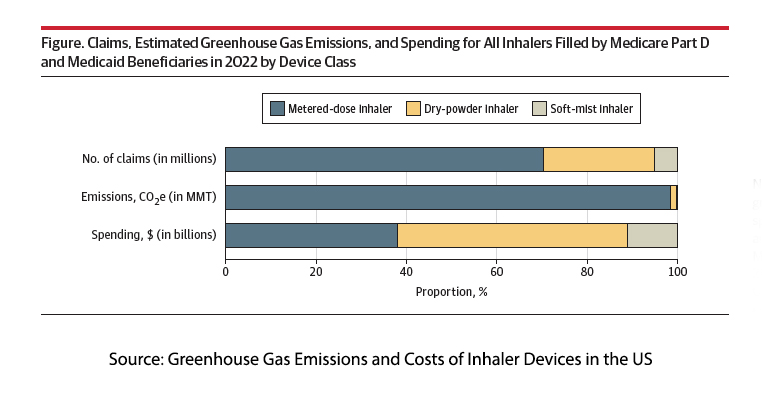
Inhalers are critical elements in the care of individuals with asthma and COPD, delivering drugs to open airways and making breathing easier and more effective. The inhalers use a variety of propellants to get those medications airborne and into your lungs. Dry powder inhalers use the force of the individual's inhalation, “snorting” the meds; soft-mist inhalers are spring-loaded and force the liquified medicine through a nozzle that aerosolizes them. Metered-dose inhalers (MDI) use a propellant, in this instance an HFA (hydrofluoroalkane). [1] The propellant is a potent greenhouse gas, and as the authors of a Research Letter in JAMA write,
“efforts to reduce inhaler-related emissions in the US have been hindered by limited data on the carbon footprint of US inhalers.”
Their letter seeks to remove that hindrance.
To get at the answer, they applied a mathemagical formula,
Emission per inhaler = Weight of Inhaler Contents × Propellant Percentage × 100-year Global Warming Potential of the Propellant. [2]
With the emissions quantified, they simply multiplied by the number of inhalers in circulation, which they obtained from Medicare data on inhaler claims and costs.

No surprises here. MDIs generated the most claims, meaning they were the most used and generated the greatest proportion of all CO2 emissions. Dry powder and soft-mist inhalers produced much less but cost a good deal more. For example, corticosteroids, long-acting β-agonist produced the most CO2, 48.1 kg for $444.37, while the analogous dry-powder had 0.898 kg CO2 for $581.60 [3]
The authors write,
“Inhaler prescriptions filled by CMS beneficiaries in 2022 resulted in an estimated 1.15 MMT of CO2e emissions, equivalent to 226 960 homes’ yearly electricity use. Metered dose inhalers were responsible for nearly all inhaler-related emissions…”
For perspective, they add that this number of homes is equivalent to “all the homes in a city approximately the size of Milwaukee for an entire year.”
In 2022, according to the EPA, we generated 4,941 million metric tons of CO2; according to Statistica, we have roughly 82 million homes. So, applying our own bit of mathemagic, we can paraphrase and say,
Inhaler prescriptions filled by CMS beneficiaries in 2022 resulted in an estimated 0.2% of all US CO2 emissions, equivalent to 0.2% of homes’ yearly electricity use.
There you have it—your trusty inhaler, the little life-saver in your pocket, also contributes to our ever-growing carbon footprint. Will patients step up to the plate and pay more to do less damage? Will the government, as the researchers suggest, “negotiate better prices for environmentally friendly inhalers?” Perhaps we might even consider a personal carbon credit? Of course, given the numbers, are we wasting our time or simply rearranging the deck chairs on the Titanic?
[1] This replaced chlorofluorocarbons, the initial propellant that was found to destroy the Ozone layer.
[2] Weight and propellant information came from package inserts. The “100-year global warming potential, which represents the earth-warming effect of a gas relative to CO2 during 100 years, was obtained from the Sixth Assessment Report of the Intergovernmental Panel on Climate Change.”
[3] Dr. Bloom, ever the chemist, wishes that I point out that none of these inhalers produce CO2, but these numbers reflect the CO2 generated by the interaction of the propellants with the atmosphere.
Source: Greenhouse Gas Emissions and Costs of Inhaler Devices in the US JAMA DOI: 10.1001/jama.2024.15331



